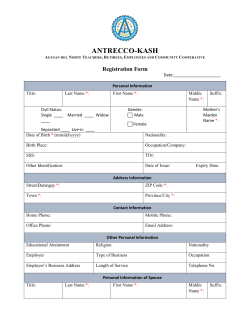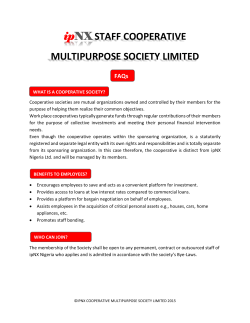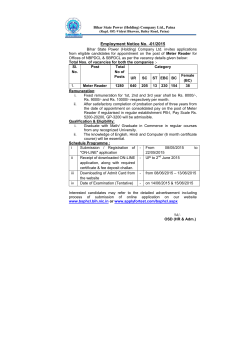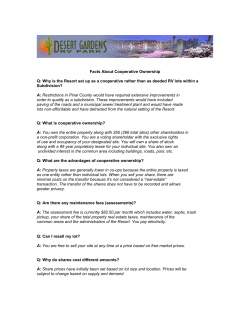
RR member pamphlet.indd - Red River Valley Cooperative Power
Welcome to Your Cooperative Program & Services Guide The Energy to Serve You Welcome Welcome to Red River Valley Cooperative Power Association. Your cooperative is not-for-profit and is owned by you, the member-owner. This gives you a voice through your democratically elected Board of Directors. The advantages of being a member are many, including the return of capital credits (margins after expenses), Lauren Brorby, CPA CEO locally owned, grassroots democracy and a commitment to providing reliable electricity at competitive rates. Red River Valley Co-op Power serves more than 4,700 accounts in Clay, Norman and Polk counties. The power you receive comes from a diversified mix of coal, water and wind energy, demonstrating our commitment to balancing affordable power with environmental goals. True to the cooperative business model, employees are dedicated to serving you with integrity and accountability. If you ever have questions, please call us at 800-788-7784 or email info@ rrvcoop.com. Board of Directors Since Red River Valley Co-op Power is member-owned, the membership elects a Board of Directors to represent them at the cooperative. Directors are elected to three-year terms. Currently, you are represented by: District 1 Roger Krostue, Fisher Kay Green, Ada District 2 Marvis Thompson, Perley Sara Tommerdahl, Hendrum District 3 Trevor Sorby, Glyndon Neil Wiser, Moorhead Check us out online to learn more g about our member p programs! www.rrvcoop.com Co-op Connections www.facebook.com/rrvcpa Your card for savings! Red River Valley Cooperative Power Association 109 Second Avenue East ✦ P.O. Box 358 ✦ Halstad, MN 56548-0358 Outages: 800-788-7784 – Email: info@rrvcoop.com 2 What are capital credits? Belonging to a not-for-profit cooperative means you are a part-owner. As such, you receive a portion of margins (called capital credits). Margins are the cushion left over after the cooperative pays its expenses. Years of service and the amount of electricity determines the amount of capital credits one receives. Margins are used to maintain ain in and and n improve imp pro rove ove v the electrical system between the time they are assigned d and returned. Your cooperative has returned more than $6 million back to its members. Loan and Rebate Program Your cooperative offers a wide variety of rebates for members who install certain energy-efficient products. Please call Member Services for information or go to www.rrvcoop.com to view all our rebates and criteria. Loans at 5 percent interest and repayable up to five years are also available for members who wish to make energy conservation improvements or install/replace off-peak heating. Members may receive up to $5,000 for the addition or replacement of off-peak heating system (including gas backups). They can also receive up to $2,500 for energy conservation measures such as insulation, caulking and windows, etc. To see if your project qualifies, call Member Services. An application is available at www.rrvcoop.com or can be mailed on request. Up front charges include a loan origination fee. Red River Valley Co-op Power will file a second mortgage on your real estate as loan security. Statement of Nondiscrimination Red River Valley Cooperative Power Association is the recipient of Federal financial assistance from the U.S. Department of Agriculture (USDA). The USDA prohibits discrimination in all its programs and activities on the basis of race, color, national origin, age, disability, and where applicable, sex, marital status, familial status, parental status, religion, sexual orientation, genetic information, political beliefs, reprisal, or because all or part of an individual’s income is derived from any public assistance program. (Not all prohibited bases apply to all programs.) Persons with disabilities who require alternative means for communication of program information (Braille, large print, audiotape, etc.) should contact USDA’s TARGET Center at (202) 720-2600 (voice and TDD). To file a complaint of discrimination, write to USDA, Director, Office of Civil Rights, 1400 Independence Avenue, S.W., Washington, D.C. 20250-9410, or call toll free (866) 632-9992 (voice) or (800) 877-8339 (TDD) or (866) 377-8642 (relay voice users). USDA is an equal opportunity provider and employer. 3 Off-Peak Program Off-peak electric heating is one of the most efficient and affordable ways to heat your home. An off-peak heating system consists of an electric heat source as its main component and a backup, automatic heating source that will typically operate between 250 and 500 hours per year during time of peak electrical usage. In exchange for allowing your electric heat to be controlled during times of peak usage, you receive a low off-peak electric heating rate (about 45 percent of our regular rate) or monthly credit for electric water heaters. A variety of efficient electric heating systems, including heat pumps, plenum heaters, floor heat and electric thermal storage systems, are compatible with off-peak provided you have a reliable and automatic back-up fossil fuel or thermal storage heating system. The exceptions to needing a back-up system are floor heat applications that have a heat storage base and a properly sized thermal storage system that releases its own stored heat during control times. For more information about the money-saving benefits of off-peak, go to www.rrvcoop.com or call 800-788-7784. Marathon Water Heaters Your cooperative sells super-efficient electric Marathon water heaters in 50, 85 and 105 gallon sizes. Marathons are not only the most energy efficient electric resistance water heater available, but they are warranted not to leak for as long as you own your home. You can save a minimum of $132 per year with an 80-gallon or larger water heater on our off-peak program. Call Member Services for prices, offpeak credit and rebate information. 4 Saving Energy Saving energy in your home doesn’t necessarily require a major investment of money or your time. Little things do add up and your cooperative is here to help. Pamphlets, direct install kits, free energy walk-throughs and online tutorials are available. For resources, call Member Services or go online to www.rrvcoop.com. Chec out our lineup of great energy Check eff online att eff ffiiciency ici cien ency cyy incentives inc ncen enti tive vess on onli l nee a www.rrvcoop.com MyMeter energy tracking view/pay bill tool Now there is an easy tool that helps take the “what?” out of your kilowatt-hour! MyMeter is a free and secure online energy information portal for Red River Valley Co-op Power members that provides your current usage information, plus gives you the ability to view and pay your bill online. You can access MyMeter directly from www.rrvcoop. com. Once at the login page, all you need to access your energy information or view/pay your bill is your account number and email address. This is also a great tool to use in conjunction with auto-pay because you can sign up for email notification to view your statements online and reduce the need for additional mailing clutter. MyMeter is a great tool for managing your energy expenses and understanding where your energy is going. 5 Your Electric Bill Your electric bill has two major parts – a facility charge and an energy charge. The facility charge is a fee charged to every member, regardless of the amount of energy used, to offset the cost of maintaining electric service at a location. It covers maintenance of poles, wires, transformers, meters, right-of-way and other expenses associated with providing electric service. The energy charge represents what your cooperative pays on average for power per kWh. Also included in this charge are all of the other associated costs in providing electric service formulated on a per kWh basis. These costs include operations, consumer billing and administration. Payment options Red River Valley Co-op Power has a variety of bill payment options to fit your lifestyle. 1. Automatic payment with email notification for viewing – This is the easiest and most cost-effective way to view and pay your bill. You save time and money by paying your monthly electric bill automatically from your checking or savings account. Plus, you receive an email notification when your bill is ready to view online, eliminating the need for yet another mailing to clutter up your table. To sign up for auto-pay, please fill out the enclosed form and return with a voided blank check. 2. Pay online with credit or debit card at www.rrvcoop.com – Signing up is easy and takes just a few simple steps. 3. Mail – Send payments to Red River Valley Co-op Power, PO Box 358, Halstad, MN 56548-0358. 4. Drop Box – A red drop box is located at the cooperative’s main entrance in Halstad. 5. Budget billing – Let’s you know exactly what you will pay each month. The plan works best when started in spring in order to build a large enough reserve to carry through the winter. If needed, the monthly budget payment can be adjusted up or down during the year. 6 General Billing Policies Electric bills are issued by the 20th each month and due the end of the month. Automated meter reading Late payment charge If not paid or postmarked before the 1st of the following month, a late charge of the greater of $2 or 1.5 percent of the balance will be added. Delinquent notice A bill that is not paid by the due date shown on the bill shall become a delinquent bill. A Reminder/Final Notice message will print on the following month’s bill. Failure to pay a delinquent bill by the specified date on the final notice may result in disconnection of service. If a member cannot pay a delinquent bill, he/she shall notify the cooperative immediately. We will attempt to work out a payment plan or explain other forms of public assistance. Failure to agree on a suitable payment plan or qualify for public assistance may result in disconnection of service. Collections If it becomes necessary to make a collection trip to the member’s home during regular working hours, a collection charge of $75 for each account will be added to the amount due. Disconnection If the collection trip results in disconnection of the electric service, another $75 fee for each account is charged to have the service reconnected during working hours or $150 after working hours (8 a.m. - 3:30 p.m.). It is the member’s responsibility to contact the cooperative to make payment arrangements on past due accounts prior to the disconnect date. Your meter contains an automated meter reading device which automatically obtains monthly meter readings. Although the system is very reliable, members should still periodically read their meter and compare it to the reading on the billing statement. If the actual reading is not close to the billing statement reading, call our office. Stopped meters If you find your meter has stopped and you are using electricity, please contact our office immediately so we can replace it. Average consumption will be billed to the member for the time the meter was stopped, so there is no advantage in not reporting a stopped meter. 7 Who owns what? Member or Cooperative Transformer poles, meter loops, wires and breaker panels – who is responsible for what? When storms damage equipment or when you are planning new construction, it’s good to know who is responsible for maintenance and repairs on your electric service. Overhead electric service Red River Valley Co-op Power is responsible for: 1. Wires from the transformer to the meter pole and electrical connections on those wires. 2. The meter pole, guy wires, ground wire and ground rod. 3. The meter. Members are responsible for: 1. The meter loop, including the meter socket. 2. Fuse and/or breaker panels including disconnect switches. 3. Wires leaving from the meter pole to services at other locations/buildings and connections for those wires. Underground electric service Red River Valley Co-op Power is responsible for: 1. Wires running from the transformer to the meter location and the connections. 2. The meter. Members are responsible for: 1. Wires running from the meter location to other locations and those connections. 2. Any disconnect switches, fuse panels or breaker panels at the meter. 3. The meter socket and mounting panel. If you have any questions about your electric service responsibilities, please call during business hours and ask for the engineering department. 8 New Service Requirements If you are adding a new service, the following steps must be completed before your service installation can be scheduled. You can also find the new service form at www.rrvcoop.com under Service. 1. Membership application. 2. Right-of-way easement (please furnish a copy of the legal description of the property). 3. Provide physical address of the property (address, street or avenue, city, zip code, and township, range and section numbers if known). 4. Pay the following fees: processing fee ($30); service fee ($250 single-phase, $500 three-phase, both nonrefundable); deposit ($100-$200 for residential, $250-$500 commercial). 5. Schedule an appointment with Engineering to meet and plan your service (be prepared to pay the initial fees in advance). Please have in mind where your other utilities are or will be located. 6. Upon completion of the preceeding steps, please contact the cooperative to schedule installation of your new electric service. The cooperative will call Gopher State One Call to request locates for telephone, cable TV, natural gas lines and rural water lines. However, the cooperative is not responsible for damage to private facilities such as cable to your satellite dish, private electrical, water, sewer, telephone, gas or sprinkler system lines. It is the owner’s responsibility to locate and expose their private facilities before construction. Any water lines buried deeper than 48 inches do not have to be exposed. If no locate has been acquired by the private landowner, the cooperative shall bear no liability if such lines are damaged during construction. 9 Reliability & Outages Despite our best efforts, power interruptions can still occur. By being prepared and informed, you can assist us in restoring power in a timely manner. If your power does go out, you should: 1. Wait a few minutes to see if the power comes back on. 2. If it does not, call neighbors to see if they have power. 3. If they are off, report that when you call in the outage. 4. If your neighbors are not out of power, check your fuses or circuit breakers in the house and on the meter pole (if you have any fuses and breakers there). This is important because if you call and the problem is on your side of the meter, you will be billed for the service call. 5. If the fuses/breakers are good, report the outage by calling 800-7887784. It is also important to report an outage during or after a major storm, even if you think we know about your outage. Service Reliability Red River Valley Co-op Power maintains more than 1,700 miles of distribution lines. To help ensure reliability, your cooperative has a right-of-way tree trimming practice to reduce the number one cause of outages. All overhead power lines shall have a clearance of 15 feet to either side of the line. If you have a tree that has grown near or into Red River’s power lines, please notify us so we can trim or cut it down if necessary. If trees must be removed or trimmed, they will be cleaned up in a professional manner. 10 Safety Red River Valley Co-op Power educates the public about electric safety in its member publication Sparks, its website and via other channels of communication. Here are a few basic safety tips: • Treat electricity with respect. Even electricity in small doses can be harmful or deadly. • Treat all downed power lines as if they are energized. Never touch them and stay away. Call Red River Valley Co-op Power immediately or the proper authorities and keep others away from the area. • Always be aware of overhead lines when planting trees or farming and keep items from contacting the lines. • Keep farm equipment at least 10 feet away from power lines. • Call 811 before you do any digging, no matter how large or small. Calling 811 gets utility-owned lines marked for free. Secondary lines owned by you can be marked by CitiLites (218-568-4744) for a fee. • Know how to use your generator, whether it is a standby or portable. A standby generator must have an approved double-throw transfer switch, so it does not allow electricity from the generator to flow backward into power lines. Without a double-throw transfer switch, 240-volt electricity may feed back to your transformer, which steps it up to 7,200 volts. As a result, a line crew working on the line or someone else who assumes the line is dead would be put in danger. Portable generators should only be used outside and only plug the appliance you plan to use into it. Never plug the generator into a wall outlet. Check out these websites for more safety tips: • www.rrvcoop.com • www.call811.org • www.safeelectricity.org 11 800-788-7784 www.rrvcoop.com ✦ info@rrvcoop.com www.facebook.com/rrvcpa The Energy to Serve You
© Copyright 2025









